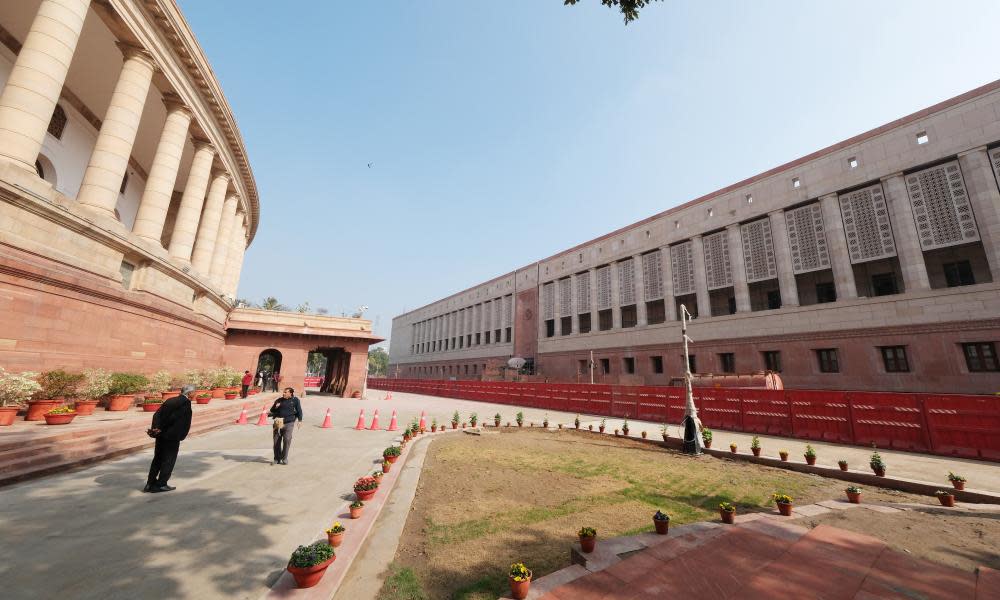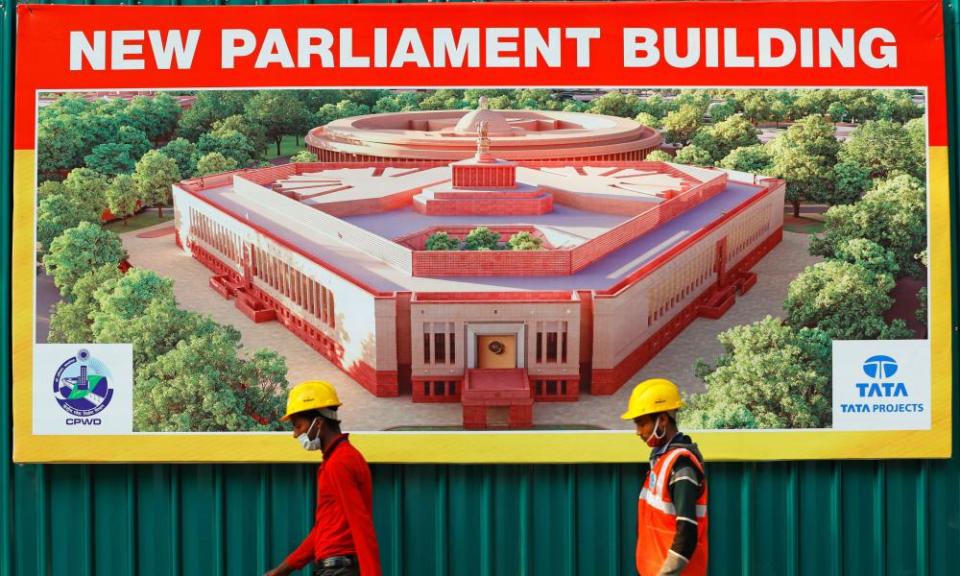A fresh era for India or a ham-fisted ego trip? Welcome to Modi’s new seat of power

Some time soon the new parliament building of the world’s largest democracy, India, will open for business. No one quite knows when, except perhaps for the prime minister, Narendra Modi, and those close to him, but it has been imminent for months. There were suggestions that it would open in time for the 75th anniversary of Indian independence last year, but the high steel hoardings around it remain in place.
The £120m project is at the centre of a culture war. For Modi and his supporters it is a statement of freedom from colonial legacy, and a poke in the eye for the old governing class of New Delhi. It is the centrepiece of the Central Vista Project, an ambitious plan to make over the city’s British-built administrative centre. Critics of the new building say that it is an unnecessary replacement of the existing parliament, that short cuts were taken with its procurement and the obtaining of permissions, and that there was minimal consultation with parliamentarians and the public.
Opposition MP Jawhar Sircar calls the project “an extension of Modi’s virulent ego and his desperate need to make a mark for himself”. Madhav Raman, a Delhi-based architect, says its design is “ham-fisted” and “awkwardly stuck together”.
Both dispute the official arguments put forward for the new building, that India’s expanding population requires a larger debating chamber than the parliament now offers, and that its 96-year-old home is worn out. “I find it perfectly all right,” says Sircar. “In India we have buildings that are 500-700 years old and still work well.”
New and old parliaments stand side by side among the grandiose array of public buildings designed and planned by the architects Edwin Lutyens and Herbert Baker about a century ago, after the British government decided to move the capital of the Indian empire from Kolkata to Delhi. They are laid out around a huge central axis, somewhat like the Mall in Washington DC, stretching 3km from the domed Viceroy’s Palace – now the Rashtrapati Bhavan or Presidential Palace – to the India Gate, an arched memorial to the country’s dead in the first world war.
Intended to symbolise and reinforce permanent British rule, the complex served its original purpose for only 16 years, from its inauguration in 1931 to Indian independence in 1947. Since then it has been the place where the country’s democratic government was forged. For some, though, it represents what a pro-Modi commentator calls an “old hierarchical elite”. The term “Lutyens gang” is used to denigrate Jawaharlal Nehru and the Congress party politicians who negotiated independence with the British, and their successors.

Modi, in the style of populist authoritarian leaders worldwide, presents himself as a disrupter of this old order, even as he imposes his own hierarchies. His Central Vista Project envisages rows of new government buildings on either side of Lutyens and Baker’s central boulevard and a £47m new prime minister’s house, as yet unbuilt. A black granite statue has been erected by the India Gate of Subhas Chandra Bose, the nationalist leader who, more militant than Nehru, befriended Nazi Germany and imperial Japan in his efforts to find allies in his struggle against the British. The boulevard, once called Kingsway, then the Rajpath – according to Modi a “symbol of slavery” – was last year renamed the Kartavya Path or “road of duty”.
The new parliament is by the architect Bimal Patel, from Modi’s home state of Gujarat. Its design is not, in fact, quite as hostile to Lutyens and Baker’s architecture as some of the prime minister’s rhetoric might suggest: while the plan is a triangle with its corners shaved off, in geometric contrast with the circular shape of the older parliament, its exterior is in pink and cream stone similar to that of its neighbour. It combines repeating vertical pillars in the style of classical architecture with motifs from traditional Indian buildings. What critics dislike is what they see as the poor quality of the new design, as well as the fact that more than 300 trees were removed to make way for the new parliament, and an open space built over. Raman calls the use of traditional details on the new building “cookie cutter … they could have been taken from a catalogue in China”. If Modi’s grand projects are meant to represent a proud modern nation, is the suggestion, they are not doing a very good job. “What inspiration is it supposed to give you?” asks Sircar.
The interiors will look somewhat hotel-like, albeit with two large debating chambers for the two houses of parliament, with decoration inspired by peacocks and lotus flowers. Patel has declined to comment.
More fundamentally, opponents of Modi question the need to remake the British architectural legacy. The journalist Harish Khare has called the renaming of the Rajpath an “extraordinary foray into historical spuriousness”. Raman believes that Indians should be “proud” of the “mature” way that governments after independence turned the imperial buildings to the purposes of the new democracy. Sircar similarly argues that the heritage of past rulers should be respected. “Otherwise,” he says, “why don’t you tear down the Taj Mahal?”

 Yahoo News
Yahoo News 
